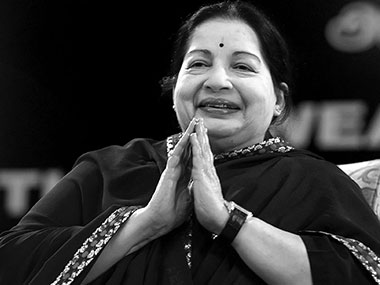Tamil Nadu chief minister Jayaraman Jayalalithaa broke every major rule of the very Dravida movement that shaped her political career, even as she honourably led a powerful party born from the movement. The reasons lie in her extraordinary ability to connect with poor voters and administrative bureaucrats alike and tapping deeper elements of a social psyche, while keeping everyone else guessing on her next move — especially leaders of her own All-India Anna Dravida Munnetra Kazhagam (AIADMK), the media and above all, her bitter rival Dravida Munnetra Kazhagam (DMK) and its leader, Muthuvel Karunanidhi. In Sanskrit, the name Jayalalithaa can be translated as “the playfully victorious one.” True to her character, she kept everyone guessing from her bed at the Apollo Hospital in Chennai until the last moment. True to her character, she fought with every breath before passing away. By the conventional rules of Tamil Nadu and indeed, Indian politics, Jayalalithaa was up against three major forces: Male dominance, anti-Brahmin sentiment and rationalist thought. She pooh-poohed them all in her political moves. [caption id=“attachment_3141540” align=“alignleft” width=“380”] File image of J Jayalalithaa. AFP[/caption] The DMK is busy marking 100 years of the Justice Party founded by the late EV Ramaswamy Naicker as its own century. Naicker was an atheist who fought Brahmin dominance. His party later became the Dravida Kazhagam, representing what it called the non-Aryan southern communities against northern and Brahmin dominance, giving birth to the Dravida movement. The DMK was carved out of the DK by the late CN Annadurai (Anna). MG Ramachandran, Jayalalithaa’s co-star in many Tamil movies and later her political mentor, broke away from the DMK after Anna’s death from the Karunanidhi-led DMK to form the AIADMK. MGR was a Keralite by birth and Jayalalithaa traced her origins to Mysuru in Karnataka where she was born in the nearby temple town of Melukote into an Iyengar Brahmin family. Both led the AIADMK with aplomb, never mind the fact that the DMK rode to power in an anti-Hindi movement that spoke for Tamil pride and also railed against Sanskrit, its parent, and Brahmins, linked to that language. By DMK’s streetsmart yardsticks, Jayalalithaa was every inch non-Dravidian — born outside Tamil Nadu, of Brahmin parentage, and a soft-spoken English-educated woman in a tribe of patriarchal, often misogynist, men. Jayalalithaa succeeded with some formulae picked up from her mentor, and some style of her own. Women, farmers and the Thevar community have formed the backbone of AIADMK’s politics, which has retained strong support for core Dravida priorities such as job reservations for backward castes while harnessing support elsewhere. The religious Thevars eagerly backed Jayalalithaa, a devout Hindu happy to perform yagnas and pose in temples while leading a big part of the once proudly atheist Dravida movement. The reasons for her success can be seen in every street corner of Tamil Nadu, where temples abound to many gods. Women are among the most devout. Jayalalithaa’s closest friend has been Sasikala Natarajan, herself from the Thevar community, though she was kept outside party politics of late. O Panneerselvam, the leader’s chief political aide and government head in her absence, is also a Thevar. Jayalalithaa also aggressively pursued welfare programmes for the poor with a focus on women. MGR launched the mid-day meal scheme in schools lauded by the World Bank, while Jayalalithaa launched her cut-rate “Amma Canteens” to feed the poor. Her most recent poll plank in her comeback victory this year included a scooter subsidy for women and special maternity aid for the pregnant. Jayalalithaa also defied Karnataka’s rulers time and again as she fasted and fought in courts and tribunals to get more waters from the Cauvery river for Tamil Nadu’s farmers, who were key to her grassroot support base. While doing all this, the leader knew how to handle the bureaucracy. Although she joined the world of cinema to help her family and did not pursue her college degree, her stellar academic record at Chennai’s elite Church Park Convent stood her in good stead as she handled bureaucrats and files with aplomb, equally fluent in English and Tamil. But in all this, she knew how to keep her glamour quotient high. Whether it was living in a palatial home, moving in a convoy of cars that made her look like a head of state, or in defying critics to stage a lavish royal-style wedding for an adopted son, the visual pomp gave for the masses a figure they held in awe. A series of corruption cases — including one in which she was temporarily convicted — did nothing to dampen her style or dent her image among the masses. Her comeback in the last state election only showed that her extraordinary connection with Tamil Nadu’s people was beyond the conventional thinking of those weaned on simple equations of caste, language and egalitarian socialism. Mystique and mystery were central to her politics. The author is a senior editor and journalist who has worked for Reuters_,_ Economic Times_,_ Hindustan Times and Business Standard_. He tweets
@madversity_
The only Hindi film in which Jayaraman Jayalalithaa acted in her long movie career was called Izzat (Honour). It is a word close to the heart of the Tamil Nadu leader
Advertisement
End of Article


)
)
)
)
)
)
)
)
)



